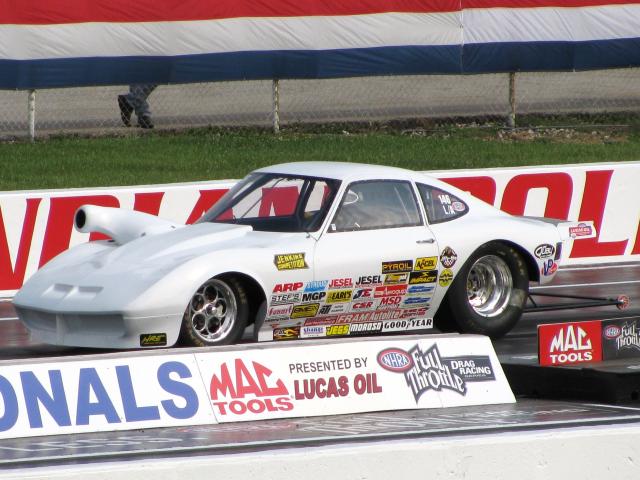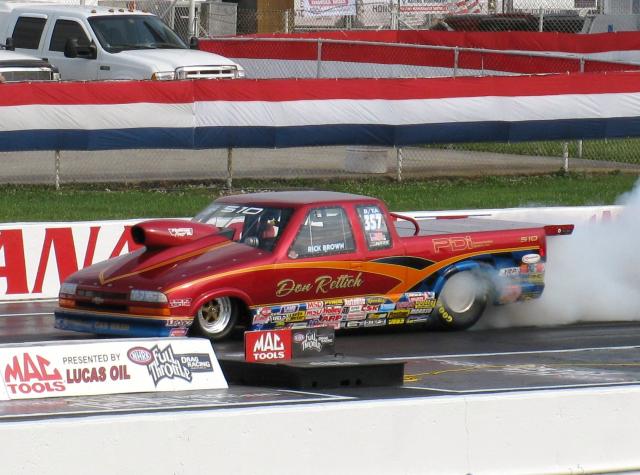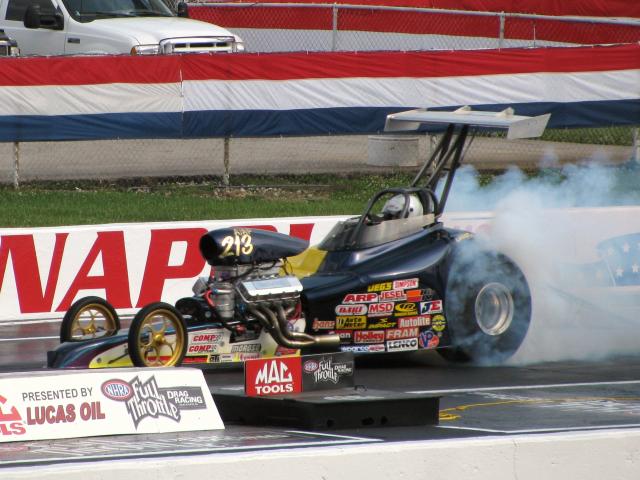Part of the fun in watching drag racing is the variety of cars, trucks, motorcycles and even snowmobiles that can show up at an event. That kind of variety, while fun for the spectator, makes some headaches for the competitors and the sanctioning body… in this case, the NHRA. The widest variety of cars competing against each other is found in the Competition Eliminator class, where almost anything is allowed except for nitro-powered race cars.
Cars are classified into a number of groups, and then divided into classes according to the power to weight ratio. Cars or trucks with automatic transmissions have their own class, which is different from those with manual transmissions. These classes then allow for cars of widely varying configuration to compete against each other, on a level playing field. In general, faster cars are handicapped by letting the slower car start first, then whoever makes it over the finish line first wins.
So in Comp Eliminator, you could easily see a front wheel drive sedan take on an alcohol burning, supercharged dragster, and either could win the race depending on reaction time and driving skill. Making that happen, though, can get a little complicated along the way. In this article, we’re going to run through the different classes and competition rules, as well as a couple of examples, to try and help you understand what’s going on. When you see some of the more improbable pairings on the track, you’ll know that it’s Comp Eliminator time!

You won't find a more diverse group of racers than in NHRA's Comp Eliminator class. Adam White's rail dragster might end up racing against the Pontiac coupe beside it. Photos: Alex Owens
Have Some Class!
There are nine sub-classes of Comp, with 96 individual classes overall. Some classes allow engines of a different manufacturer than the car (example, a Dodge Hemi in a Chevy or Ford, etc) They are:
- Gas Dragster: 13 classes, from A/D, using Pro Stock-type motors and even bigger, down to H/D and I/D which are turbocharged. Four, 6 and 8 cylinder cars are all permitted in different classes. Some are for V-6 or inline 6 cylinder engines only, while some permit or are limited to 2 and 4-valves per cylinder. A, B, C and D/D also have separate classes for manual and automatic transmissions.
- Econo Dragster: 7 classes. Created in the 1980’s, the term econo is really a misnomer, as there is very little economical about them. Econo classes are limited to a single four barrel carburetor and automatic transmission only. A/ED through G/ED are the classes, again each with their own engine rules and requirements.
- Nostalgia Dragster: 2 classes. Created a few years ago for front engine dragsters with mechanical fuel injection, on methanol and using a Powerglide transmission, these dragsters resemble dragsters from the 1960’s, yet can run in the high 6’s with a relatively small V8 (380-410 cid for most cars).
- Altered: 37 classes. With door cars and front engine, open wheel altereds, these classes have it all. A/A to L/A, A/AA to L/AA for automatics, A/AP and B/AP (for cars using a planetary transmission), AA/A and BB/A for blown gas cars, AA/AM and BB/AM for blown methanol-burning cars, AA/AT to DD/AT for turbocharged cars, AA/AF and BB/AF for turbocharged front wheel drive cars. You see it all here from six-second big V8’s, low seven-second turbocharged four cylinders, screaming small blocks to loud blown cars.
- Street Roadster: 3 classes. A/SR to C/SR for pre-1937 style topless, full bodied street roadsters
- Truck, 6 classes: P/ST, B/T and C/T, one class each for stick and automatics. P/ST uses the same formula as the now defunct Pro Stock Truck class that was run in NHRA from 1997 to 2001. Extended cab, mid size (Ranger, S-10 and Dakota), 1997 and newer trucks are permitted.
- Econo Altered: 8 classes. A/EA to G/EA. Same rules as Econo Dragster. Door cars and open wheel altereds permitted.
- Super Modified: 18 classes. For stock-appearing, 1967 and newer door cars. A/SM to I/SM, with a stick and auto class for each. V6 required in I, V8’s in A to H. Corporately correct engines (Chevy engine permitted in any GM car, etc). Some classes allow two 4 barrels, some a single 4 barrel.
- Pro Mod: 2 classes. AA/PM for blown cars, A/PM for nitrous oxide-assisted big engine cars. The same types of cars you’ve seen for years in NHRA and IHRA, this allows Pro Mod cars to compete at Lucas Oil Divisional races and National Events as a sportsman too.
How Comp is Run

Small cars can bring just as much racing action as the bigger ones do. Here, Mike Iacono lifts the front end to get more traction at the back.
Comp is a unique class that combines handicap racing with all-out, first to the finish line wins. You’ll remember in my article about Stock Eliminator that each individual class has an index, which they qualify against. The quicker (further under) you run against the index, the higher you qualify in the order. In Comp, 32 cars qualify, maximum.
Unlike Stock and S/S, where you can dial-in under the index, in Comp, the index is your handicap. For example, the A/D index is 7.03, while the H/SM index is 9.54. So, in eliminations, the H/SM gets a 2.51 second head start. First one to the finish line wins. Unlike Stock, Super Stock and bracket racing, there is no going too fast, and there are no breakouts–sort of.
In order to maintain a level, competitive playing field, the Competition Index Control (CIC) was developed in the 1980’s, to prevent runaway indexes. During eliminations, a competitor who runs more than a half-second (.50) under their index will have their index temporarily reduced by one hundredth (.01) for each hundredth under that they ran.
Meaning, if I am in an A/D and run a 6.510 in winning the first round, that is -.520 under the original index of 7.03, so for second round, my index will now be 7.01. These hits are temporary, and affect only me. Only my A/D is penalized. If another A/D wins first round and does not run more than .50 under the 7.03, their index will stay at 7.03 for the second round.
If I continue to win, and continue to run more than .50 under my new index, it will continue to be reduced. Eventually, those temporary “hits” can turn into a permanent one. Once a racer, in eliminations, runs more than an accumulated -.610 under the original index, it becomes a permanent “hit”, that affects all A/D racers in the country. If I win a race and run no more than a cumulative -.609 under my original 7.03 index, my index will return to 7.03 at the next event.
If I win that race, however, and in the final I run a 6.380, that is -.650 under the original 7.03 index, after this event, every A/D in the country will now run off a 6.98 index (a .05 penalty). Permanent index hits are as follows:
- .610 to -.619 under the original index = .01 permanent index adjustment
- .620 to -.629 under the original index = .02 permanent adjustment
- .630 = .03 adjustment
- .640 = .04 adjustment
- .650 to -.709 = .05 adjustment
- .710 = .06 adjustment
- .720 = .07 adjustment
- .730 = .08 adjustment
- .740 = .09 adjustment
- .750 and more = .10 adjustment
The most a racer can be hit at any one race is a tenth of a second (.10). This can be quite a setback for some. A car that runs really fast in the spring and fall, on the 7.03 index, now in hot summer weather when the cars don’t run as fast, would be running on a 6.93. So you want to be careful how fast you go. Ideally, you want to get to the stripe first, by as little a margin as possible, to limit potentially damaging index hits. So in a way, it is sort of like bracket racing in that sense, but unlike bracket racing, you have to get to the finish line first to win in Comp.
Here are two scenarios, to better explain.
Scenario #1
A/D, index 7.03
Round 1, index 7.03, I run 6.510, -.520, so second round index is now 7.01
Round 2, index 7.01, I run 6.480, -.530, so third round index is now 6.98
Round 3, index 6.98, I run 6.480, -.500, no penalty
Round 4, index 6.98, I run 6.450, -.530, so for the final my index is 6.95
Round 5, index 6.95, I run 6.440, -.510 under.
Since it is the final, no more rounds, so no penalty for the next round. My total, accumulated CIC hits add up to .09, so no permanent hit is received and my index will go back to 7.03 at the next race, as well as all A/D racers’ index (unless another A/D at that same race made a run of more than -.610 under the 7.03 during the event).

A small engine in Dave Yediny's altered coupe puts it in the L/A class. If it was running an automatic transmission, it would be classed as L/AA.
In the case that I race someone in my Class during eliminations (another A/D racer), it is heads-up, going back to the old index. So, using the above example, if I race an A/D in round three, and my temporarily adjusted index is 6.98, and another A/D racers index was adjusted to 7.01, we would both run off the original 7.03 index. The winner would go into round 4, going back to his/her adjusted index, plus any “penalty” incurred on that run.
Scenario #2
A/D, index 7.03
Round 1, index 7.03, I run 6.510, -.520, so second round index is now 7.01
Round 2, index 7.01, I run 6.480, -.530, so third round index is now 6.98
Round 3, index 6.98, I run 6.480, -.500, no penalty
Round 4, index 6.98, I run 6.450, -.530, so for the final my index is 6.95
Round 5, index 6.95, I run 6.380, – 570.
I have accumulated a total of .15 in penalties (-.650 under the original index), so effective Monday morning, myself and all other A/D racers will be running against a 6.98 index instead of 7.03. This prevents a particular car, or class as a whole, from dominating the entire class of Comp Eliminator.
To the uninitiated, NHRA’s Competition Eliminator rules can seem overly elaborate, but it takes these considerations to maintain a level playing field when dealing with the extensive range of cars and trucks that show up. We hope this helps you understand the sometimes complicated, but always exciting Competition Eliminator classes. Until next time…
Additional Resources
If you want to dig a little deeper into this class of racing, here are a few more places to check out:
Southern California Competition Eliminator Club



















